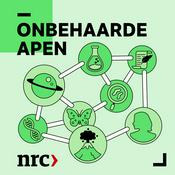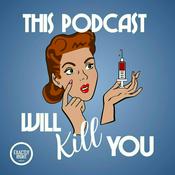Beschikbare afleveringen
5 van 23
- Going on a Trip: Science of PsychedelicsIn this episode, I explore the history, science, and clinical promise of psychedelics. This was actually my Master's Thesis topic so very fun episode for me! We cover everything from how the psychedelics actually work, by acting brain (serotonin) receptors to increase neuroplasticity (make your brain more malleable), disrupt rigid brain patterns, and increase brain "entropy"... and, more importantly, why those effects may help us treat conditions such as PTSD and treatment‑resistant depression. The episode also discusses the current clinical evidence (including a critical appraisal of its robustness), logisitcal and ethical challenges, and the importance of use within therapeutic / research settings only. As always, find a full bibliography below: Carhart-Harris & Goodwin (2017), “The Therapeutic Potential of Psychedelic Drugs: Past, Present, and Future,” Neuropsychopharmacology - This one is a very good foundation if you only have time to read one paper, it should be this one!! Yaden & Griffiths (2021), “The Subjective Effects of Psychedelics Are Necessary for Their Enduring Therapeutic Effects,” ACS Pharmacology & Translational Science - This is great to read into the question of "is the trip actually necessary?" Mitchell JM et al. MDMA-assisted therapy for severe PTSD: a randomized, double-blind, placebo-controlled Phase 3 study. Nature Medicine. 2021. Mitchell JM et al. MDMA-assisted therapy for PTSD: results of a second Phase 3 randomized trial in a diverse cohort. Nature Medicine. 2023. Carhart-Harris RL et al. Trial of psilocybin-assisted therapy versus escitalopram for major depressive disorder. New England Journal of Medicine. 2021. Davis AK et al. Effects of psilocybin-assisted therapy on major depressive disorder: outcomes at 1 and 4 weeks. JAMA Psychiatry. 2020. Raison CL et al. Psilocybin versus niacin placebo for major depressive disorder: a randomized clinical trial. JAMA Psychiatry. 2023. Bogenschutz MP et al. Psilocybin-assisted treatment for alcohol use disorder: a randomized clinical trial. JAMA Psychiatry. 2022. Griffiths RR et al. Psilocybin produces substantial and sustained decreases in depression and anxiety in patients with life-threatening cancer. Journal of Psychopharmacology. 2016. Luoma JB et al. Meta-analysis of placebo-controlled trials of psychedelic-assisted therapy. Journal of Psychoactive Drugs. 2020. Fang Y et al. Psilocybin for depressive and anxiety symptoms: systematic review and meta-analysis of randomized trials. Frontiers in Psychiatry. 2024. Romeo B et al. Safety of psychedelic-assisted therapies: systematic review and meta-analysis. Psychiatry Research. 2024. Hinkle JT et al. Adverse events in psychedelic-assisted therapy: a systematic review and pooled analysis. JAMA Psychiatry. 2024. Siegel AN et al. Persistent decreases in hippocampus-default-mode connectivity following psilocybin correlate with mood improvement. Nature. 2024. Ly C et al. Psychedelics promote structural and functional neural plasticity. Cell Reports. 2018. Carhart-Harris RL, Friston KJ. REBUS and the anarchic brain: toward a unified model of the brain action of psychedelics. Pharmacological Reviews. 2019. Griffiths RR et al. Psilocybin-occasioned mystical-type experience in humans: relationship to persisting positive effects. Psychopharmacology. 2019. U.S. Food and Drug Administration. Guidance for Industry: Expedited Programs for Serious Conditions. Drugs and Biologics (Breakthrough Therapy Designation). FDA; 2014 (update). Compass Pathways plc. Phase 3 program design of COMP360 (synthetic psilocybin) for treatment-resistant depression (TRD). Business Wire/Investor Press Release. 2024. Johnson MW, Garcia-Romeu A, et al. Pilot study of psilocybin-facilitated smoking cessation treatment: long-term follow-up outcomes. Journal of Psychopharmacology. 2017.--------36:01
- You will Never Forget this Episode: Science of MemoryIn this episode of Science Savvy, I explore how memory shapes identity and human culture. The episode covers the evolutionary origins of memory, the brain regions involved, how memories are encoded, and how therapies (including MDMA) can help heal traumatic memories. You will also get practical tips to improve your memory! About Science Savvy: My name is Carmen Fairley, I have a background in pharmacology and biomedical engineering, and currently work in medical advisory. Science Savvy is a podcast that makes cutting-edge research accessible, turning complex science into stories that mean something for you. Citations / Bibliography: Chudek, Maciej, and Joseph Henrich. “Culture-gene coevolution, norm-psychology and the emergence of human prosociality.” Trends in cognitive sciences vol. 15,5 (2011): 218-26. doi:10.1016/j.tics.2011.03.003 Brockmeier, Jens. “Memory, Narrative, and the Consequences.” Topics in cognitive science vol. 11,4 (2019): 821-824. doi:10.1111/tops.12412 Sridhar, S., et al. Cognitive neuroscience perspective on memory. PMC 2023 Markowitsch, H. J. Memory and Self–Neuroscientific Landscapes. PMC 2013 D’Argembeau, A., et al. Brains creating stories of selves: the neural basis of autobiographical reasoning. PMC 2013 Martinelli, P., et al. Neural substrates of the self‑memory system: New insights. PMC 2012 Richerson, P. J., & Boyd, R. Gene‑culture coevolution in the age of genomics. PMC 2010 Strikwerda‑Brown, C., et al. “All is not lost” – Rethinking the nature of memory and self in dementia. PMC 2019 Repetto, C., et al. The neuroscience of body memory: Recent findings and implications. PMC 2023 Dégeilh, F., et al. Neural correlates of Self and its interaction with memory in adolescence. PMC 2015 Pais‑Vieira, C., et al. The influence of self‑awareness on emotional memory. PMC 2015--------28:14
- Cris Cancer: Who is funding tomorrow's cancer cure?In this episode of Science Savvy, I sit down with Elena Muyo, Scientific Projects & Partnerships Lead at CRIS Cancer UK, to uncover how this unique charity is rewriting the future of cancer research. From dual CAR-T trials in children with leukemia, to a first-in-class lung cancer vaccine, to pioneering treatments for devastating childhood brain tumors, CRIS Cancer is driving science that gives patients options when medicine says “there’s nothing more we can do.” We talk about the incredible story that started it all, how CRIS selects and funds projects that others overlook, and why every pound donated has a multiplying effect on hope and discovery. If you’ve ever wondered how patient-driven science can change the course of cancer treatment, this is the episode for you. About Science Savvy: My name is Carmen Fairley, I have a background in pharmacology and biomedical engineering, and currently work in medical advisory. Science Savvy is the podcast that makes cutting-edge research accessible, turning complex science into stories that mean something for you. Citations / Bibliography: National Cancer Institute. What Is CAR T-Cell Therapy? cancer.gov Maude SL, Frey N, Shaw PA, et al. Chimeric antigen receptor T cells for sustained remissions in leukemia. New England Journal of Medicine. (also available via PMC) Fesnak AD, June CH, Levine BL. Engineering T cells: the intersection of synthetic biology and adoptive cell therapy. Nature Reviews Cancer. June CH, Sadelain M. Chimeric antigen receptor therapy. New England Journal of Medicine. Newick K, Moon E, Albelda SM. CAR T cell therapy for solid tumors. Annual Review of Medicine. Frontiers in Immunology / Frontiers in Oncology. Articles on CAR-T in solid tumors and tumor microenvironment challenges. Cancer Research UK / CRIS Cancer Foundation. LungVax project announcement. news.cancerresearchuk.org Elliott T (et al.). Details of neoantigen-based lung cancer vaccine design (as reported by CRUK) BioNTech / mRNA vaccine clinical trial reports (e.g., BNT116 in lung cancer). PMC articles / reviews on checkpoint inhibitors in lung cancer (e.g. anti‑PD‑1 / anti‑PD‑L1 therapies). Frontiers in Immunology / Frontiers in Oncology – studies combining immunotherapy in thoracic cancers, mechanisms of resistance, tumor microenvironment. National Cancer Institute / NIH press / Cancer Currents. CAR T trial in DMG. Studies on ONC201 in H3K27M mutant gliomas (e.g. University of Michigan / clinical trial reports). Reviews of prognosis and therapeutic challenges in diffuse midline glioma (e.g., clinical trial databases, Pediatric Neuro‑Oncology journals). American Cancer Society / Cancer.org. Overview of Clinical Trial Phases. Cancer Research UK. Explanation of how clinical trials work, purposes of phases I, II, III. Lupus Research / NIH / NCI / adaptive trial methodology sources. Phase I/II and Phase II/III design explanations.--------40:51
- Genetics of Schizophrenia with Aitana PadillaIn this episode we talk about "having great genes", but also weird ones, ancient viral ones, and even one named after Sonic Hedgehog (look it up!). W dive into how your DNA is more like a script with a dimmer switch than a fixed destiny. From epigenetics and retroviruses to schizophrenia research, stem cells, and the pitfalls of 23andMe, we explore the science written into your genome. Thank you to Aitana Padilla for coming on the show. Aitana is a neuroscientist in training with a deep focus on the genetics of mental health. She currently investigates how human endogenous retroviruses (remnants of ancient viral infections embedded in our DNA) may influence schizophrenia! Further reading and references: Human Endogenous Retroviruses as Pathogenic Factors in Schizophrenia: Slokar G, Hasler G. Front Psychiatry. 2016;6:183. doi:10.3389/fpsyt.2015.00183. Implication of human endogenous retroviruses in schizophrenia and bipolar disorder: Ellul P, Groc L, Leboyer M. Med Sci (Paris). 2017;33(4):404-409. doi:10.1051/medsci/20173304010. Heritability of Schizophrenia and Schizophrenia Spectrum Based on the Nationwide Danish Twin Register: Hilker R et al. Biol Psychiatry. 2018;83(6):492-498. doi:10.1016/j.biopsych.2017.08.017. Schizophrenia as a Complex Trait: Evidence from a Meta-analysis of Twin Studies: Sullivan PF et al. Arch Gen Psychiatry. 2003;60(12):1187-1192. doi:10.1001/archpsyc.60.12.1187. Huntington's Disease: A Clinical Review: Roos RA. Orphanet J Rare Dis. 2010;5:40. doi:10.1186/1750-1172-5-40. The Relationship Between Cannabis Use, Schizophrenia, and Bipolar Disorder: A Genetically Informed Study: Cheng W et al. Lancet Psychiatry. 2023;10(6):441-451. doi:10.1016/S2215-0366(23)00143-8. Induction of Pluripotent Stem Cells from Adult Human Fibroblasts by Defined Factors: Takahashi K et al. Cell. 2007;131(5):861-872. doi:10.1016/j.cell.2007.11.019. Induction of Pluripotent Stem Cells from Mouse Embryonic and Adult Fibroblast Cultures by Defined Factors: Takahashi K, Yamanaka S. Cell. 2006;126(4):663-676. doi:10.1016/j.cell.2006.07.024. Animal Models of CNS Disorders: McGonigle P. Biochem Pharmacol. 2014;87(1):140-149. doi:10.1016/j.bcp.2013.06.016. Advances Toward Precision Medicine for Bipolar Disorder: Haggarty SJ et al. Mol Psychiatry. 2021;26(1):168-185. doi:10.1038/s41380-020-0831-4.--------29:38
- Genetics: You Are More Viral Than You ThinkWelcome to the Genetics episode, part of Science Savvy with Carmen. In this episode, I am joined by neuroscientist and PhD researcher Aitana Padilla Requerey. Leveraging my background in pharmacology and biomedical engineering, I speak with Aitana to better understand gene expression, viral DNA, and genetic editing. This episode covers the role of ancient viral elements embedded in our genome, how epigenetics acts like a dimmer switch on gene activity, and how genetic tools like CRISPR are changing the future of medicine. Aitana earned her Bachelor of Science in Neuroscience from UCLA, graduating with a perfect 4.0 GPA and conducting research on Multiple Sclerosis using advanced lab techniques. She went on to complete a Master of Science in Clinical Neuroscience at UCL, where she worked on mouse models to investigate molecular systems involved in antiviral responses and their relevance to diseases like Alzheimer’s. Now, as a PhD candidate, she’s investigating how ancient viruses embedded in our DNA may influence the development of schizophrenia, bridging genetics, virology, and psychiatry in her groundbreaking research. Whether you’re curious about DNA, mental health, or how the environment shapes your biology, this episode offers clear and engaging insights grounded in real research. Science Savvy helps you understand the systems shaping your thoughts, health, and behavior. If you're ready to explore your body and brain with a little more clarity, you're in the right place. Further reading and references: Bohacek, J., & Mansuy, I. M. (2015). Epigenetic inheritance of disease and disease risk. Neuropsychopharmacology, 40(1), 245–262. https://pubmed.ncbi.nlm.nih.gov/20643310/ Champagne, F. A., & Curley, J. P. (2009). Epigenetic mechanisms mediating the long-term effects of maternal care on development. Neuroscience & Biobehavioral Reviews, 33(4), 593–600. https://pubmed.ncbi.nlm.nih.gov/20363720/ Feil, R., & Fraga, M. F. (2012). Epigenetics and the environment: Emerging patterns and implications. Nature Reviews Genetics, 13(2), 97–109. https://pubmed.ncbi.nlm.nih.gov/22906839/ Muller, P. A. J., & Vousden, K. H. (2014). Mutant p53 in cancer: New functions and therapeutic opportunities. Cancer Cell, 25(3), 304–317. https://pubmed.ncbi.nlm.nih.gov/30538286/ Mantovani, F., & Collavin, L. (2024). TP53 mutations in cancer: Molecular features and therapeutic implications. Molecular Oncology. https://pubmed.ncbi.nlm.nih.gov/39450536/ Balestrieri, E., et al. (2011). Human endogenous retrovirus type W (HERV-W) in schizophrenia. Current Issues in Molecular Biology, 14(3), 123–130. https://pubmed.ncbi.nlm.nih.gov/21936762/ Frank, O., et al. (2005). Human endogenous retrovirus expression in brains of patients with schizophrenia and bipolar disorders. Journal of Virology, 79(17), 10890–10901. https://pubmed.ncbi.nlm.nih.gov/26793126/ Ripke, S., et al. (2014). Biological insights from 108 schizophrenia-associated genetic loci. Nature, 511(7510), 421–427. https://pubmed.ncbi.nlm.nih.gov/25056061/ Sullivan, P. F., et al. (2018). Genetic architectures of psychiatric disorders. Nature Reviews Genetics, 19(8), 537–551. https://pubmed.ncbi.nlm.nih.gov/31780348/ Chiang, C., et al. (1996). Cyclopia and defective patterning in mice lacking Sonic hedgehog. Nature, 383(6599), 407–413. https://pubmed.ncbi.nlm.nih.gov/9205942/ Briscoe, J., & Small, S. (2015). Sonic Hedgehog signaling in neural tube patterning. Development, 142(21), 3771–3780. https://pubmed.ncbi.nlm.nih.gov/36672161/ Takahashi, K., & Yamanaka, S. (2006). Induction of pluripotent stem cells by defined factors. Cell, 126(4), 663–676. https://pubmed.ncbi.nlm.nih.gov/16904174/ Okita, K., et al. (2011). Integration-free human iPS cell generation. Nature Methods, 8(5), 409–412. https://pubmed.ncbi.nlm.nih.gov/26883003/ Bosley, K. S., et al. (2015). CRISPR germline engineering—The community speaks. Nature Biotechnology, 33(5), 478–486. https://pubmed.ncbi.nlm.nih.gov/28879860/ Brokowski, C., & Adli, M. (2019). CRISPR ethics: Moral considerations. Journal of Molecular Biology, 431(1), 88–101. https://pubmed.ncbi.nlm.nih.gov/29885329/ Hogarth, S., et al. (2008). Direct-to-consumer genetic testing: Legal, ethical, and policy issues. Annual Review of Genomics and Human Genetics, 9, 161–182. https://pubmed.ncbi.nlm.nih.gov/18852208/--------37:23
Meer Wetenschap podcasts
Trending Wetenschap -podcasts
Over Science Savvy
Welcome to Science Savvy, where I, Carmen Fairley, leverage my background in Pharmacology and Biomedical Engineering to explore the extraordinary science behind everyday life. I want you to fall in love with science like I did, and realise it doesn't have to be inaccessible jargon. We cover topics from interviews with researchers at the forefront of healthcare, through to mental health, and even topics around love, friendship, and family, to help YOU see that cool science is EVERYWHERE. New episodes every two Fridays. Follow now and never miss an episode!
Podcast websiteLuister naar Science Savvy, De Universiteit van Nederland Podcast en vele andere podcasts van over de hele wereld met de radio.net-app

Ontvang de gratis radio.net app
- Zenders en podcasts om te bookmarken
- Streamen via Wi-Fi of Bluetooth
- Ondersteunt Carplay & Android Auto
- Veel andere app-functies
Ontvang de gratis radio.net app
- Zenders en podcasts om te bookmarken
- Streamen via Wi-Fi of Bluetooth
- Ondersteunt Carplay & Android Auto
- Veel andere app-functies


Science Savvy
Scan de code,
download de app,
luisteren.
download de app,
luisteren.






































